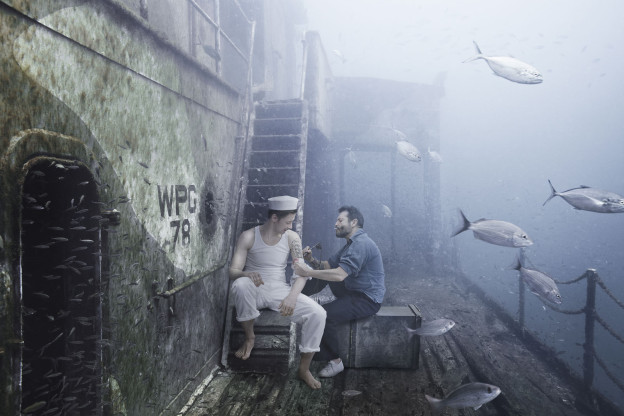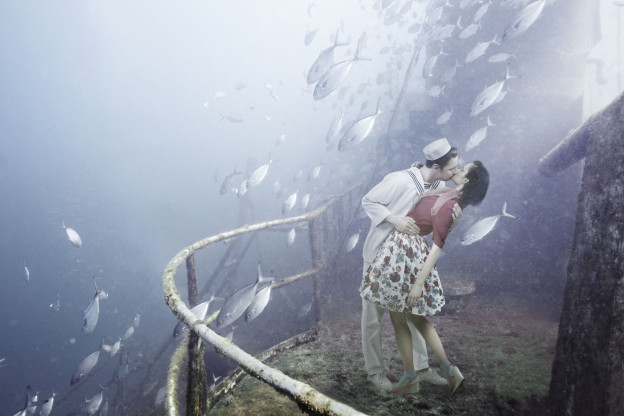
Austrian artist Andreas Franke has turned an artificial reef made from the hull of a World War II Coast Guard cutter into a fine art gallery with a naval twist.
Almost 90 feet below the Gulf of Mexico, Franke has hung a dozen magnetized picture frames on the side of USS Mohawk CGC (WPG-78), a 1,005 ton cutter sunk July 2, 2012 to create an artificial reef 28 miles of coast of Florida.
The images on display are pictures of the ship taken shortly after Mohawk was sunk super imposed with models Franke shot in his Vienna studio, the diver/photographer told USNI News on Tuesday.
View The Sinking World Gallery in a larger map
“I shot a couple of hundred of images,” he said.
“Then back to the boat and back to Europe.”
Franke dressed his models in generic sailor uniforms and posed them getting into fights, handling lines, getting tattoos and smooching their sweet hearts on the deck.
“It’s more a fantasy story,” he said.

Franke got the idea after diving SS Thistlegorm, an armed British merchant ship sunk by German bombers in the Red Sea in 1941.
The idea stayed with Franke when we met Joe Weatherby, a commercial boat captain turned artificial reef creator base in Florida.
Weatherby and his company, Reefmakers, had sunk the radar ship USNS General Hoyt S. Vandenberg (T-AGM-10) as an artificial reef off the Florida coast.
Working with Reefmakers, Franke used pictures of the Vandenberg as a backdrop to create a 2011 underwater exhibition. The Vandenberg exhibition juxtaposed Viennese imagery of ballet dancers and women in refined pouf hairdos lounging with the rust covered decks surrounded by the local aquatic wildlife.
So far, turning the reefs into galleries have meet with a positive response and have helped bolster the case for turning more decommissioned military ships into artificial reefs, Weatherby told USNI News on Tuesday.
“The fish can’t tell the difference between a pile of shopping carts and the USS Arizona, he said.
“And the veterans hate it when they’re cut up into razor blades.”
Decommissioned military ships are most often bought by scrap dealers who recycle the ship’s metal into raw materials for other products.
Weatherby was able to convince the owners of Mohawk — once a floating museum — to use the ship as a reef when the ship began to deteriorate.

“ Mohawk is an example of the way artificial reefs should be done,” he said.
“It’s keeping the legacy of the ship alive.”
James Delgado — Director of Maritime Heritage for the National Marine Sanctuaries Program at the National Oceanic and Atmospheric Administration — liked the idea of the gallery, he told USNI News on Tuesday.
“We’re not talking about a ship that was sunk,” Delgado said.
“This is not the Arizona, the Titanic or the Monitor… Not every wreck on the bottom should be set-aside as a museum.”
Delgado said the exhibition made the ships out to be more than things.
“These were floating communities,“ he said.
“I think [Franke] hit the nail on the head.”
For Weatherby’s part, he’s glad the exhibition draw attention to artificial reefs.
Not only do ships like Mohawk draw millions in tourist money from divers to Florida communities, the ships are whole in their new roles.
“Better at rest than toenail clippers,” he said.





